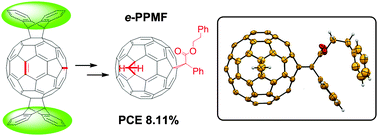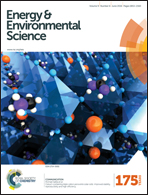Development of isomer-free fullerene bisadducts for efficient polymer solar cells†
Abstract
Isomer-free fullerene bisadducts have been predicted to be high-performance acceptors for bulk-heterojunction (BHJ) solar cells. They can afford a higher open-circuit voltage compared with monoadducts because of the higher LUMO levels, and can also provide a higher short-circuit current and fill factor compared with the isomer mixture because of reduced energetic disorder. However, the application of isomer-free fullerene bisadducts in BHJ solar cells has met synthetic challenges. In this work, a new regioselective synthesis method, the so-called prebisaddition-confined bisfunctionalization (PCB), was developed for preparing isomer-free C60 bisadducts. This synthesis was highly selective for obtaining homo- and hetero-bisadducts with an “e configuration”. Isomer-free C60 bisadducts, e-C60[C(CO2tBu)2]2, e-NC60BA and e-PPMF, were successfully synthesized via PCB. The gram-scale synthesis of e-C60[C(CO2tBu)2]2 was realized. Single crystals of e-PPMF and two intermediates were obtained. Electrochemical studies proved that a single isomer has reduced energetic disorder. e-PPMF featuring a compact methano group and a solubilizing side chain showed good performance in P3HT and low-bandgap polymer solar cells. A decent power conversion efficiency (PCE) of 8.11% was achieved in solar cells consisting of e-PPMF and the low-bandgap polymer PPDT2FBT. The outstanding photovoltaic performance of e-PPMF among the fullerene bisadducts results from its better packing and reduced energetic disorder.


 Please wait while we load your content...
Please wait while we load your content...